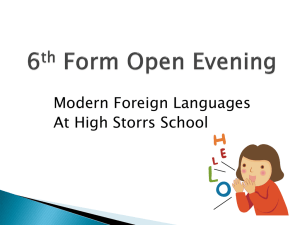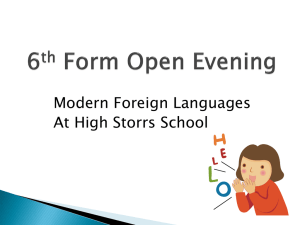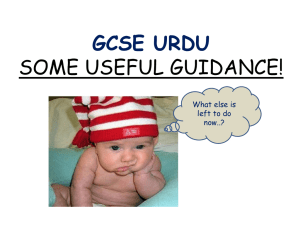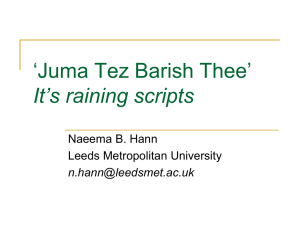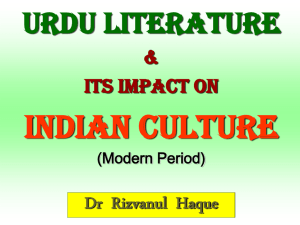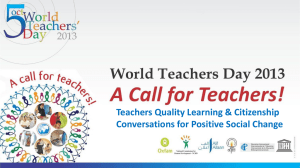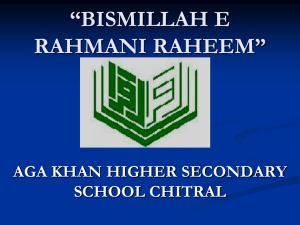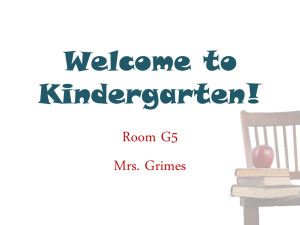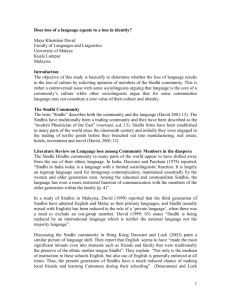Dr. Tariq Rahman
advertisement
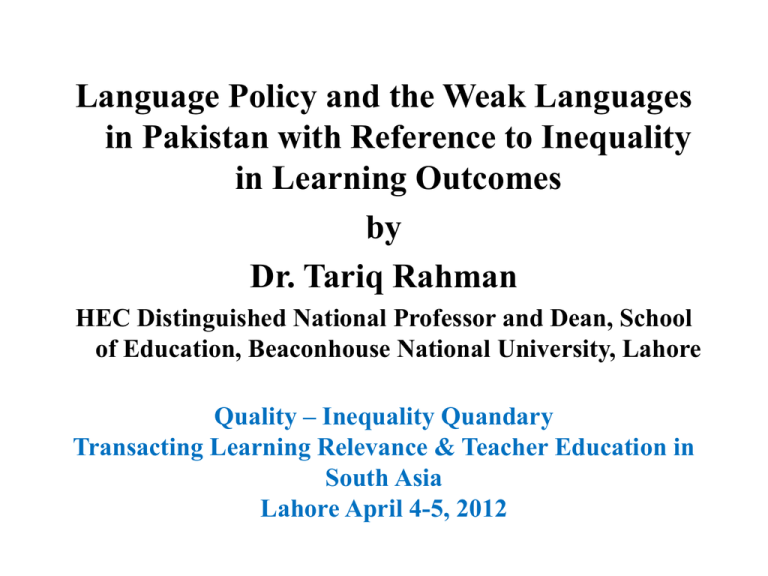
Language Policy and the Weak Languages in Pakistan with Reference to Inequality in Learning Outcomes by Dr. Tariq Rahman HEC Distinguished National Professor and Dean, School of Education, Beaconhouse National University, Lahore Quality – Inequality Quandary Transacting Learning Relevance & Teacher Education in South Asia Lahore April 4-5, 2012 BOX - 1 LANGUAGE PERCENTAGE OF SPEAKERS NUMBER OF SPEAKERS Punjabi 44.15 66,225,000 Pashto 15.42 23,130,000 Sindhi 14.10 21,150,000 Siraiki 10.53 15,795,000 Urdu 7.57 11,355,000 Balochi 3.57 5,355,000 Others 4.66 6,990,000 Source: Census 2001: Table 2.7. The population is assumed to be 150 million in 2003 as it was 132, 352,000 in 1998 and the growth rate is 2.69 per cent. Box – 2 MOTHER TONGUE SPEAKERS SECOND LANGUAGE SPEAKERS Hindi 366,000,000 487,000,000 Urdu 60,290,000 104,000,000 Total 426,290,000 591,000,000 Grand Total:Mother tongue + second language speakers of Urdu-Hindi = 1,017,290,000. Source: Grimes 2000: see under ‘Pakistan’ and ‘India’ entries. Box -3 Language Community & Location Balochi Baloch/Lyari (Karachi) one No. of students/schools 650 up to 2011 Remarks Started in 2003 school at Shahigoth & one in In two pre-primary Maroro. The latter was schools. Now there are shifted to Machi Goth in four schools 2009. Kachi Mirpur Khaas Two schools Offers education up to Magsi Goth One called Nya Swera class-5 & the other Amar Ujala Parkari Mirpur Khaas 27 Schools Offers education up to Rattanabad. 1200 students class-5 Isolated villages of the Tharparkar & Nagar region Source: Rehman and Zaman 2011a Language Palula Community & No. of students Location /schools Ashret Two pre-schools After one year of MLE, Urdu (Chitral) Remarks and English are introduced. Students did better than nonMLE ones in English & Maths. Kalasha Bamboret One school (Chitral) Offers education up to class-5. English & Urdu are introduced from the beginning MLE students did better in language proficiency and mathematics. Gawri Kalam Two schools Two-years pre school MLE (Swat) from 2008 to programme 2011 40 students Torwali Bahrain One school Up to class-5. However, by the MINOR LANGUAGES AND DIALECTS OF PAKISTAN Language Other Names/ Where Spoken or Dialect Lexical Similarity to other Languages and Dialects Aer None. 78% lexical similarity with Katai Meghwar and Kachi Bhil. 76% with Raburi; 76% with Kachi Koli. Speakers Source Jikrio Goth around 200 in Deh 333, 1996 Hyderabad and Jamesabad. Also in Kach Bhuj in Gujrat (India). Badeshi (Badakhshi) Dialect Bishigram, (Chail) 400 plus see Persian of Persian. Lexical Valley, (Swat, in 2002 similarity with Kohistan) Persian, Badakshan variety. Grimes 2000: 589 Grimes 2000: 589; SSNP Zaman 2004 Bagri (Bahgri ; Bagria; Bagris; Baorias; Bauri). Dialect of Rajasthani 74% lexical similarity with Marwari Bhil of Jodhpur; 54% with Jandavra. Sindh and Punjab (nomadic between India and Pakistan) 200,000 Grimes in 2000: Pakistan 589. including 100,000 in Sindh Balti Baltistani, Sbalti Baltistan 27,000300,000 Bateri (Bateri Kohistani; Batera Kohistan; Baterawal; Baterawal Kohistani) 58-61% lexical similarity with Indus Kohistani; 60% with Gurgula. Indus Kohistan Batera village (East of Indus North of Besham) 20,000- Breton 30,000 1997: (in 1992) 200; Grimes 2000 SSNP-2: 8& Grimes 2000 Bhaya Lexical similiarity to Marwari sweeper 84% and to Malhi 75%; Bhat 73%; Goaria,72-73%; Sindhi Meghwar 7073%, Sindhi Bhil 6371% and Urdu 70%. Kapri Goth near 70-700 Khipro Mirpur (in 1998) Khas (Lower Sindh) Brahvi Brohi, Brahuidi, Kurgalli, Brahuigi, (no similarity with any language in Pakistan but with many loan words from Persian, Balochi and Urdu. Kalat region and East Balochistan. Also spoken by small communities in Sindh and Iran etc. Grimes 2000 2,000,000 Grimes in Pakistan 2000: and 590. 2,210,000 in all countries (1998). Burushaski Mishaski, Biltum, Werchikwar Khajuna (language isolate with no similarity with any language. Some words borrowed from Urdu, English and Shina). Chilisso Hunza, Nagar, Yasin valleys (Northern areas) 55,000- SSNP-2: 60,000 37 (in 1981) Grimes 2000: 590. (Chiliss, Galos) Koli, Palas, Jalkot 160070% lexical Indus Kohistan 3000 similarity with (in 1992) Indus Kohistani; 6568% with Gowro; 50% Bateri; 48-65% with Shina. Breton 1997: 200 & Grimes 2000: 590. Dameli (Gudoji, Damia, Damedi, Damel) 44% lexical similarity with Gawar-Bati, Savi, and Phalura, 33% with Kamviri, 29% with Kativiri. Damel Valley 2000SSNP-5: (Southern Chitral) 5000 11 (in 1992) Grimes 2000: 590. Dehwari also see Persian (Deghwari) Iranian language somewhat close to Persian and influenced by Brahvi. Kalat, Mastung (Central Balochistan) 10,000- Breton 13,000 1997: 200 (in 1998) & Grimes 2000: 590. Dhatki (Dhati) Dialects are Eastern, Southern and Central Dhatki, Malhi and Barage. Varies from Northern Marwari but intelligible. 7083% lexical similarity with Marwari dialects. Lower Sind in Tharparkar and, Sanghar. 200,000 Grimes plus 2000: 590 (in 1987) Domaaki (Domaski, Doma) loan words from Shina and Burushaski but not intelligible to speakers of both. Mominabad (Hunza & Nagar) 300 plus SSNP 2: (in 2002) 79; Grimes 2000: 590. Personal observati on in 2002. GawarBati (Narsati, Nurisati, Gowari, Aranduiwar, Satr, Gowar-bati) 47% lexical similarity with Shumashti, 44% with Dameli, 42% with Savi and Grangali. Southern Chitral, Arandu, Kunar river along PakistanAfghanistan border 1500 SSNP-5: (in 1992) 156 Breton 1997: 200 & Grimes 2000: 591. Ghera (Sindhi Ghera, Bara) Quite different grammatically from Gurgula and similar to Urdu. 87% lexical similarity with Gurgula. 70% with Urdu. Hyderabad Sindh 10,000 Grimes (in 1998) 2000 Goaria 75-83% lexical Cities of Sindh similarity with Jogi; 76-80% with Marwari sweeper; 72-78% with Marwari Meghwar; 70-78% with Loarki. 20,000- Grimes 25,000 2000: 591 (in 1998) Gowro (Gabaro, Gabar Khel) 62% lexical similarity with Indus Kohistani; 60% with Bateri; 65-68% with Chilisso; 40-43% with Shina. 200 or Breton less 1997: 200 (in 1990) & Grimes 2000: 591. Indus Kohistan (on the eastern bank, Kolai Area, Mahrin village) Gujari (Gujuri, Gojri, Gogri Kashmir Gujuri, Gujuri Rajasthani) close to Hindko and related varieties of Greater Punjabi. 64-94% lexical similarity among dialects. Swat, Dir, Northern areas, Azad Kashmir and Punjab 300,000700,000 plus (in 1992) SSNP-3: 96 & Grimes 2000: 591. Gujrati (Gujrati) Karachi, other parts of Sindh. Major language in India. 45,479,0 Grimes 00 in 2000: 439 India and and 591. 46,100,0 00 in all countries. Probably 100,000 in Pakistan. Gurgula (Marwari, Ghera) 87% Lexical similarity with Ghera Karachi, cities of Sindh 35,000 Grimes (in 1998) 2000 Hazargi (Hazara, Hezareh, Hezare’i) similar to Persian 220,000 Grimes (in 1998) 2000: 592. Hindko (Hazara Hindko, Peshawar Hindko, Hindki) a variety of Greater Punjabi. Intelligible to Punjabi and Siraiki speakers. Quetta and other cities of Pakistan. Also in Afghanistan. Mansehra, Abbottabad, Haripur, Attock Districts. The inner city of Peshawar and Kohat etc. Jandavra (Jhandoria) 74% lexical similarity with Bagri and Katai Meghwar, 68% with Kachi Koli. Southern Sindh from Hyderabad to Mirpur Khas 5000 Grimes (in 1998) 2000: 592. 3,000,00 Grimes 0 in 1993 2000: i.e. 2.4% 592. of the populatio n. Jatki Kabutra Kachchi Kalami (Jatgali, Jadgali, Jat) Southern Balochistan and Southwest Sindh. Also in Iran. (Nat, Natra) Umarkot, Kunri, intelligibility with Nara Dhoro Sansi and Sochi. (Sindh) 74% lexical similarity with Sochi. (Cutch, Kachi) Karachi similar to Sindhi. (Bashgharik, Dir Kohistani, Bashkarik, Diri, Kohistani, Dirwali, Kalami Kohistani, Gouri, Kohistani, Bashkari, Gawri, Garwi) Upper Swat Khoistan from Kalam to upper valleys also in Dir Kohistan 100,000 in both countries (1998) 1,000 (in 1998) Grimes 2000: 592. Grimes 2000 50,000 Grimes (in 1998) 2000: 592. 60,000- Baart 70,000 1999: 4 (in 1995) Kalasha (Kalashwar, Urtsuniwar, Kalashamon, Kalash) Kalash Valleys 2900SSNP-5: (Chitral) Southern 5700 11; (in 1992) Grimes 2000: 593. Kalkoti 69% lexical similarity with Kalami but Kalami speakers do not understand Kalkoti. Dir Kohistan in Kalkot village Kamviri (Skekhani, Chitral (Southern Kamdeshi, end of Bashgal Lamertiviri, Kamik) Valley) there is a variety of Kativiri also called Skekhani. 6000 Breton (in 2002) 1997: 200; Zaman 2002; Grimes 2000: 593 2000 SSNP-5: (in 1992) 143; Grimes 2000: 593. Kashmiri (Keshuri) The Valley of Kashmir & Diaspora in Pakistan Kativiri (Bashgali, Kati, (Chitral) Gobar Nuristani, Shekhani) Linkah Valleys Eastern Kativiri in Pakistan. 3700Grimes 5100 2000: (in 1992) 593; Strand 2004. Khetrani Similar to Siraiki but influence by Balochi Few Grimes thousand 2000: (in 1987) 593. Northeast Balochistan 4,391,00 0 in India. About 105,000 in Pakistan (in 1993) Breton 1997: 200; Grimes: 2000: 593 Khowar (Chitrali, Qashqari, Chitral, Arniya, Patu, Kohwar, Northern areas, Kashkara) Ushu in northern Swat 250,000 SSNP-5: plus (in 11 Breton 1993) 1997: 200; Grimes 2000: 593. Kohistani (Indus Kohistani, Dir Indus Kohistan Kohistani, Kohiste, West bank of Khili, Maiyon, Maiya, river Shuthun, Mair) 220,000 Grimes (in 2000: 594. 1993) Koli Kachi (Kachi, Koli, Kachi Koli) similar to Sindhi and Gujrati (78% lexical similarity) but being influenced more by Sindhi in Pakistan. Its dialects are Rabari, Kachi Bhil, Vagri, Katai Meghwar, Zalavaria Koli and Tharadari Koli. (Lower Sindh) 170,000 Grimes around Towns (in 2000: 594. of Tando 1998) Allahyar & Tando Adam also in India around the Rann of Kach. Koli Parkari Parkari (Lexical similarity with Marwari Bhil and Tharadari) 77-83% lexical similarity with Marwari Bhil; 83% with Tharadari Koli Lower Thar Desert Nagar Parkar. Also in India. 30,000 Grimes (in 1980) 2000: 594. Koli Wadiyara (Wadiyara, Wadhiyara) intelligibility with Kachi Koli and its varieties. Sindh in an area bounded by Hyderabad, Tando Allahyar and Mirpur Khas in the north, and Matli and Jamesabad in the South. 175,000- Grimes 180,000 200: 594. in Pakistan) . Total in Pakistan and India 360,000 (1998). Kundal Shahi Neelam Valley, Azad Kashmir Lasi Las Bela District (south east Balochistan) Sindh---various places (Lassi) similar to Sindhi but influenced by Balochi. Loarki 82% lexical similarity with Jogi and 80% with Marwari. Marwari (Rajasthani, Meghwar, Jaiselmer, Marawar, Marwari Bhil) 7983% lexical similarity with Dhatki; 87% between Southern and Northern Marwari; 78% Marwari Mehwar and Marwari Bhat. 500 (in 2003) Baart and Rehman 2003 15,000 Grimes (in 1998) 2000: 594. 25,000 Grimes (in 1998) 2000 Northern Marwari 220,000 Grimes in South Punjab (in 1998) 2000: North of Dadu 595. Nawabshah. Southern Marwari in Tando Mohammad Khan and Tando Ghulam Ali etc. Memoni Similarities to Sindhi and Gujrati Karachi Unknown Grimes 2000: 595. Od (Odki) similarity with Marathi with some Gujrati features. Also influenced by Marwari and Punjabi 70-78% lexical similarity with Marwari, Dhatki and Bagri. Scattered in Sindh 50,000 & south Punjab (in 1998) Grimes 2000: 595. Ormuri (Buraki, Bargista) 25-33% lexical similarity with Pashto. Kaniguram 3000? (south Waziristan) some in Afghanistan SSNP-4: 54 Grimes 2000: 595. Persian (Farsi, Madaglashti Persian in Chitral Dari, Tajik, Badakhshi and the dialects mentioned earlier). Dialects of Persian spoken in Pakistan. The standard variety is used for writing. Balochistan, Shishikoh Valley in Chitral, Quetta, Peshawar, etc. 2000SSNP-5: 3000 11 (in 1992) Grimes 2000: 591. Phalura (Dangarik, Ashreti, Tangiri, Palula, Biyori, Phalulo) 5658% lexical similarity with Savi; 38-42% with Shina 7 villages near Drosh, Chitral possibly 1 village in Dir Kohistan 8600 SSNP-5: (in 1990) 11; Grimes 2000: 596. Sansi (Bhilki) 71% lexical North-western similarity with Sindh Urdu; 83% with Sochi. 10,000 Grimes (in 1998) 2000: 596 Shina (Sina, Shinaki, Brokpa) Giligit, Kohistan, Baltistan and Ladakh Sindhi Bhil (Bhil) close to Badin, Matli, Sindhi. Its varieties Thatta (Sindh) are Mohrano, Sindhi Meghwar, Badin etc. Torwali (Kohistani, Bahrain Kohistani) 44% lexical similarity with Kalkoti and Kalami. 500,000 SSNP-2: 93; Grimes 2000: 596. 50,000 Grimes (in 1998) 2000: 597 Chail and Bahrain 60,000 (Swat) Breton 1997: 200; Lunsford 2001; Grimes 2000: 597. Ushojo (Ushoji) 35-50% lexical similarity with varieties of Shina. Upper part of Bishigram Valley (Chail) in Swat Vaghri (Vaghri Koli) 78% Sindh many lexical similarity places. Also in with Wadiyara Koli. India. 90,000 in Grimes India. 2000: 10,000 in 597. Pakistan. (in 1998) Wakhi (Kheek, Kheekwar, Wakhani, Wakhigi, Wakhan) some influence of Burushaski. 9,000 SSNP-2: plus 61; (in 1992) Grimes 2000: 597. Northern ends of Hunza & Chitral 1000 Zaman (in 2002) 2002; Grimes 2000: 597. Wanetsi (Tarino, Chalgari, Wanechi) 71-75% lexical similarity with Southern Pashto. Harnai (East of Quetta) Yidgha (Yidghah, Upper Lutkoh Luthuhwar) 56-80% Valley lexical similarity (Western Chitral) with Munji in Afghanistan. Also influenced by Khowar. 95,000 SSNP-4: (in 1998) 51 Breton 1997: 200 Grimes 2000: 598 5000SSNP-5: 6000 11 (in 1991) Grimes 2000: 598. STATE OF THE LANGUAGES OF PAKISTAN Language Material available Names of writers of primers. Material in standard Persian may be used. Many primers Alphabet book, primers, folktales, health books, phrase book Balochi-Urdu-English dictionary, printed books on Islamic observances, poetry, modern literature, textbooks etc. Ancient records (Devanagari based script); Grammar, parables (Roman); verse, folksongs etc (Nastaliq script) Tan et. al. 1999; Farrell 1986; Aer Badeshi Bagri Balochi Balti Bateri Hussanabadi 1990 Bhat Bhaya Bhil Sindhi Material in Sindhi may be used. Brahvi Alphabet book, primers, folktales, health books, phrase book; Brahvi-Urdu-English dictionary, printed books on Islamic observances, poetry, modern literature, textbooks etc. Transition primer (Urdu to Burushaski), Nasir n.d folktales, bilingual vocabulary: BurushaskiEnglish Burushaski Many primers. Many primers. Chilisso Dameli Dehwari Dhatki Alphabet book, primer, transition primer, folktales, stories for children. Das et. al. 1991; Payne 1991; various 1991 Domaaki Gawarbati Ghera Goaria Gowro Gujari Poetry books, short stories, songs etc. Many primers. Gujrati Primers, grammars, textbooks, books etc. (in India also in computers). Many primers. Alphabet book, folktales, health books, proverbs, stories for children. Material in standard Persian may also be used. Primers, literature, prose, dictionaries, magazines etc. HLA 1997 Gurgula Hazargi Hindko Jandavra Akbar 1994 and other primers. Jatki Primers, word lists, grammars. Naskh/Nastaliq Baloch 2003 Primers of Sindhi may be used Many primers Kalami Alphabet book, transition primer, poetry books, collection of texts from Gawri writers’ workshop, proverbs, phrase dictionary Gawri-Urdu-English KCS 2002; Sagar 2002a; Sagar 2002b; Shaheen 1989 Kalasha Alphabet book, pre-reader, dictionary. Akbar 1994 Jogi Kabutra Kachchi Kachchi (Bhil) Kachchi (Katiawari) Kalkoti Kamviri Kashmiri Primers, folktales, poetry, textbooks, other books etc. (most of this literature is in India). Many primers. Khojki Ancient records, Ginans, old documents, primers, school textbooks, others books. Ali 1989. Khowar Primers, grammar, dictionary, folktales, Faizi 1987 poetry, religious books, other popular books. Kativiri Khetrani Kohistani (Indus) Koli (Tharadari) Koli (Kachi) Alphabet books, folktales, health books, stories for children, primer. Koli (Parkari) Alphabet book, primer, folktales, health books, bilingual vocabulary: ParkariEnglish, stories for children. Koli (Wadiyara) Kundal Shahi Lasi Loarki Marwari Memoni Primers of Sindhi may be used Od Ormuri Primer, grammar, word list [Roman] verse, prose, grammar, word list Ormuri (Pashto script) Masih and Woodland 1995. Hoyle 1996; Hoyle, R 1990; Hoyle, R & Samson 1985; Hoyle, R et. al. 1990. Many primers Barki 1999 Pashto Persian All kinds of textbooks and books; usable in Many computer. (also used in Afghanistan in some primers. domains of power). All kinds of books (usable in computer). Many primers. Phalura Punjabi Sansi Shina Sindhi Sindhi Bhil Books on literature; history; textbooks etc in Many Nastaliq script. (All kinds of books in the primers. Gurmukhi script in India). Poetry, grammar, word lists, folktales, songs, religious books etc. All types of books and in the computers. Taj 1999; Zia 1986; Namus 1961; Kohistani and Schmidt 1996 Many primers. Siraiki Ancient poetry, modern literature, magazines etc. Mughal 1987 and other primers. Torwali Lexicographic work using Nastaliq is in progress. Bashir 2002; Kareemi 1982 Urdu All types of books and computers. Many primers. Vaghri Wakhi Primer, word list, folksongs, proverbs, word Sakhi 2000 lists. Wanetsi Primer, songs, folktales, word lists Nastaliq (Pashto variant) Yidgha Ancient poetry, modern literature, magazines etc. Askar 1972 DOMAINS OF USE AND VITALITY OF THE LANGUAGES OF PAKISTAN Language Domains of Use Vitality Source Aer Used in all functions within the group. Worship songs in Gujrati Women monolingual. Men multilingual, generally in Sindhi. No evidence of language shift but shift possible to Sindhi as children go to school. Jeffery 1999 Badeshi Not known Language shift to Pashto Zaman 2002 Bagri Used in all functions All multilingual mostly in within the group. Sindhi. No evidence of Used in weddings; to language shift. tell Jokes; in songs. Jeffery 1999 Balti Used in all functions within the group. Used by teachers as informal medium of instruction for small children if they are MT speakers themselves. Also cultivated by language activists, media persons (radio announcers etc). Some bilingualism in Urdu Backstrom especially among the in SSNP-2 educated and the employed. 1992 Positive attitude to MT. Desirous of learning to read their language. No evidence of language shift. Bhat Not known All multilingual mostly in Marwari. Jeffery 1999 Bhil Sindhi Used in traditional ceremonies and worship. Bilingualism in Sindhi. Jeffery 1999 Bateri Bhaya Burushaski Used in all Some multilingualism in functions within the Pashto and Urdu group. especially among the educated and those who travel on business. Positive attitude towards MT. No evidence of language shift. Not known Shifting to Sindhi and related to Marwari dialects. Hallberg in SSNP-1 1992. Used in all functions within the group. Used by teachers as informal medium of instruction. Also cultivated by language activists, media persons etc. Backstrom in SSNP-2 1992 Increasing bilingualism in Urdu and English however, the language is being maintained desirous of learning Urdu and English but expressing positive feelings for MT. Grimes 2000: 590 and Personal information. Chilisso Many speakers do not use the language even at home. Bilingualism in Shina. Language shift to Shina in progress. People want their children to learn Shina and Urdu. Hallberg in SSNP-1 1992. Dameli Spoken by older people at home but younger people use other languages also. Multilingualism in Pashto and Khowar. However, positive attitude to MT is expressed. Possibility of language shift to Pashto. Decker in SSNP-5 1992. Dehwari Not known Influenced by Brahvi Grimes 2000: 590. Dhatki Used by the Malhi Multilingualism in many group for all languages. functions. Urdu and Sindhi used for songs Jeffrey 1999. Domaaki Possibly used by very Language shift to Backstrom few elderly people with Burushaki is complete with in SSNP-2 each other. Most people no hope of reversal. 1992 do not know it. GawarBati Used for all functions within the group. Multilingualism in Pashto Decker in and to a lesser extent in SSNP-5 Khowar. Positive attitude to 1992 MT. However, the language is under pressure by Pashto. Ghera Used for all functions within the group. Multilingualism in Sindhi Jeffrey and Urdu. 1999 Getting influenced by both. Goaria Used for all functions within the group. Hindi used in worship. Children use Sindhi and Urdu. Multilingualism in many languages. Children use Sindhi or Urdu with outsiders. Jeffery 1999 Gowro Gujari Still spoken by the older people but younger people mix it with Shina and sometimes speak only Shina. Used in some communities but not among in Gujars settled in the Punjab and Azad Kashmir. Language activists are creating literature in the language. Songs, music and other things are broadcast from the radio and there is a TV programme from India. Bilingualism in Shina. Language shift to Shina in progress. Hallberg in SSNP-1 1992; Zaman 2004 Multilingualism in many languages and especially Urdu among the educated. In the NWFP, Northern areas and parts of Azad Kashmir the language is maintained. In the Punjab and near Muzaffarabad and Mirpur there is language shift to the local languages. Educated people use Urdu. Hallberg and O’ Leary in SSNP-3 1992 Gujrati Used for conversation within the family but younger people are switching to Urdu or English (depending on socio-economic class). All kinds of literature exists. Used in the media and in the state of Gujrat in India. Multilingualism in Urdu and Field English as well as other research in languages. Language shift to Karachi. Urdu and English is in progress at least in Pakistan. Gurgula Language used within community is strong. Multilingual in many language. Hazargi Used in the group for Multilingualism with all functions. Pashto, Balochi and Persian. Language is under pressure. Jeffery 1999 Jatki Not known Not known - Jandavra Private. People proud of their language. Jeffery 1999 Jogi Used in the group for all functions. Women slightly bilingual in Sindhi. Men preficent in Sindhi. Jeffery 1999 Kabutra Used in the group for all functions. Multilingual in many languages. Positive attitude and pride in language. No shift. Jeffery 1999 Kachchi (Bhil) Used in the group for all functions. Bilingualism in Sindhi. Being rural it is maintained at presest shift to Sindhi going on. Jeffery 1999 Shift to Sindhi going on. Jeffery 1999 Kachchi Used by older (Katiawari) people in some domains. Koli Kachi Used for all functions Multilingualism in Sindhi within the group. but language being maintained. Koli Parkari Used for all functions Multilingualism in Sindhi within the group. but language being maintained. Koli Wadiyara Used for all functions Multilingualism in Sindhi within the group. but language being maintained. Used for all functions Men Multilingual in many within the group. languages. Women and children maintain the language Used for all functions Widespread bilingualism in within the group. Pashto. Educated people also know Urdu. Attitude towards MT positive and no language shift is observed. Koli Tharadari Kalami Grainger & Grainger 1980: 42 Grainger & Grainger 1980: 42 Jeffery 1999 Jeffery 1999 Rensch in SSNP-1 1992 Kalasha Used for all functions Positive attitude to MT but Decker in within the group. those who convert to Islam SSNP-5 shift to Khowar or the 1992. language of the spouse. Some multilingualism in Khowar and Urdu because of tourism and education. The language is under pressure and there is a possibility of language shift. Kalkoti - Kalami used is a second language. Most people also speak Pashto. Grimes 2000: 593. Kamviri Used for all function within the group. Multilingualism in Pashto and surrounding languages. Positive attitude to MT but under pressure by Pashto. Decker in SSNP-5 1992. Kashmiri Small diaspora in Pakistan but used for all function within the Valley of Kashmir held by India. All kinds of literature available. Used in media and in teaching etc. Also taught at university level. Multilingualism with Urdu and the local languages. Language shift in progress in Pakistan but is maintained in India. Kativiri Used in all functions within the group. Positive attitude towards the Decker in MT but men multilingual in SSNP-5 Pashto and surrounding 1992. languages. Difficult to predict language shift. Khetrani Aziz 1983; Bukhari 2000. Khowar Kohistani (Indus) Used in all domains in the group. Used by teachers as informal medium of instruction for small children if they are MT speakers themselves. Also cultivated by language activists, media persons (radio, TV announcers etc). Used for all functions within the group. Some bilingualism in Pashto, local languages and Urdu, the last especially among the educated and the employed. Positive attitude to MT. Desirous of learning to read their language. No language shift observed. Decker in SSNP-5 1992. Multilingualism in Pashto Hallberg in and Shina is not common SSNP-1 even among them. Positive 1992. attitude towards MT. People want it as a medium of instruction for small children. No language shift is observed. Koli (Kachi) Probably used in the group Bilingualism in Sindhi. Jeffrey 1999; Grimes 2000: 594. Koli Parkari Not known Bilingualism in Sindhi but language being maintained. Grimes 2000: 594. Kundal Shahi Used only by the elderly in the family. No longer used by children. Language shift to local language and Urdu in progress. Baart and Abdurehm an 2003. Lasi Not known Not known - Loarki Used for all functions Multilingualism in Sindhi within the Loar and some knowledge of group Urdu. Marwari Used in all domains (Southern) of the group. Multilingualism in Sindhi. Jeffery 1999 Memoni Probably used by older speakers in the group as spoken language. Most speakers are educated and multilingual in Sindhi, Urdu and Gujrati. The language is shifting to these three languages. Grimes 2000: 595. Od Used in some Od communities while others use local languages. Multilingualism in Grainger & surrounding languages. Grainger Language shift in progress in 1980: 31 this iterant community. Ormuri Used for most functions in the Kaniguram area. Words of Pashto are common among young people. Bilingualism with Pashto. Though positive attitude to MT is expressed, language shift to Pashto is visible. Hallberg in SSNP-4 1992: Barki PC 2000. Persian Used for speaking in different groups. Standard Persian is used if written. Personal observation. Phalura Used at home. Used informally by teachers. Multilingualism in Khowar, Pashto and Urdu. Language shift to Khowar in evidence. However, ethnic Kalasha have shifted to Phalura in some areas. Vitality picture mixed. Decker in SSNP-5 1992. Rabari Used in all domains of the group. Being maintained. Jeffery 1999 Sansi Used for worship and weddings. Multilingualism in Sindhi and slightly in Urdu and Siraiki. No language shift observed. Jeffery 1999 Shina Used in all domains in the group. Used by teachers as informal medium of instruction for small children if they are MT speakers themselves. Also cultivated by language activists, media persons (radio announcers etc). Considerable bilingualism in Urdu especially among the educated and the employed. Positive attitude to MT. Ambivalent about learning to read their language. No language shift observed. However, there is pressure of Urdu. Backstro m in SSNP-2 1992 Sochi Used in singing, weddings and telling stories. Multilingualism in Sindhi and slightly in Urdu. Jeffery 1999 Torwali Not known Men bilingual in Pashto but language being maintained. Grimes 2000: 597 Ushojo (Ushuji) Used at home at least by the older speakers. There is much mixing of Pashto. Multilingualism in Pashto and Torwali but educated people know Urdu. Young people who know the MT use Pashto in some areas. Language is under threat from Pashto. Language vitality is varied and mixed. Decker in SSNP-1 1992 Vaghri Used in private domains. Bilingualism in Sindhi. Positive attitude to the language in spite of pressures. Jeffery 1999 Wakhi Used in all domains of the group. Language activists and radio broadcasters also cultivate it. Bilingualism with Urdu Backstrom among younger, educated in SSNP-2 people. Also knowledge of 1992 Burushaski. Positive attitude towards MT. Desirous of learning the written language in school. However, the language is under pressure from Urdu. Wanetsi (Waneci) Used in private domains but those who live in cities do not use it. Bilingualism with Pashto. Positive attitude towards MT. However, under pressure from Pashto. Yidgha Used for in group functions. Used informally by teachers and for explaining religious texts. Multilingualism in Khowar Decker in and sometimes Urdu, SSNP-5 Persian and Bashgali. 1992. Language shift to Khowar in evidence. Hallberg in SSNP-4 1992. Askar n.d.
